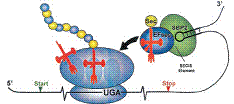Biochemistry, Department of

Vadim Gladyshev Publications
Document Type
Article
Date of this Version
7-2-2002
Abstract
Known eukaryotic selenocysteine (Sec)-containing proteins are animal proteins, whereas selenoproteins have not been found in yeast and plants. Surprisingly, we detected selenoproteins in a member of the plant kingdom, Chlumydomonas reinhardtii, and directly identified two of them as phospholipid hydroperoxide glutathione peroxidase and selenoprotein W homologs. Moreover, a selenocysteyl-tRNA was isolated that recognized specifically the Sec codon UGA. Subsequent gene cloning and bioinformatics analyses identified eight additional selenoproteins, including methionine-Ssulfoxide reductase, a selenoprotein specific to Chlumydomonas. Chlumydomonas selenoprotein genes contained selenocysteine insertion sequence (SECIS) elements that were similar, but not identical, to those of animals. These SECIS elements could direct selenoprotein synthesis in mammalian cells, indicating a common origin of plant and animal Sec insertion systems. We found that selenium is required for optimal growth of Chlumydomonas. Finally, evolutionary analyses suggested that selenoproteins present in Chlumydomonas and animals evolved early, and were independently lost in land plants, yeast and some animals.


Comments
Published in The EMBO Journal Vol. 21 No. 14 pp. 3681-3693, 2002. Copyright European Molecular Biology Organization. Permission to use.